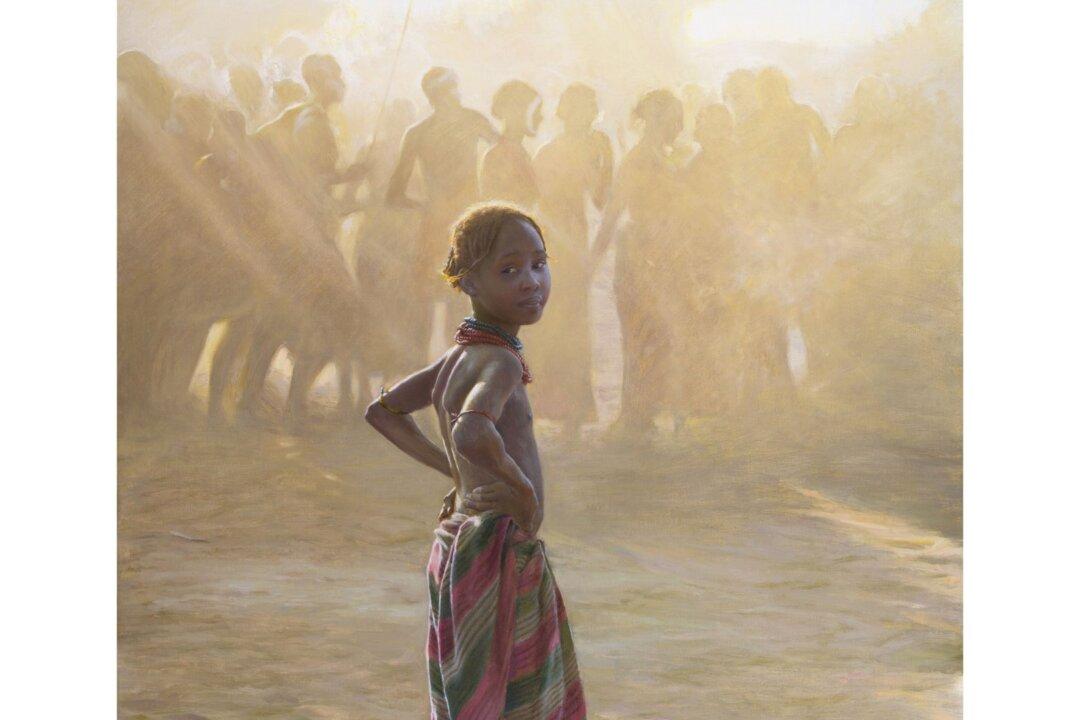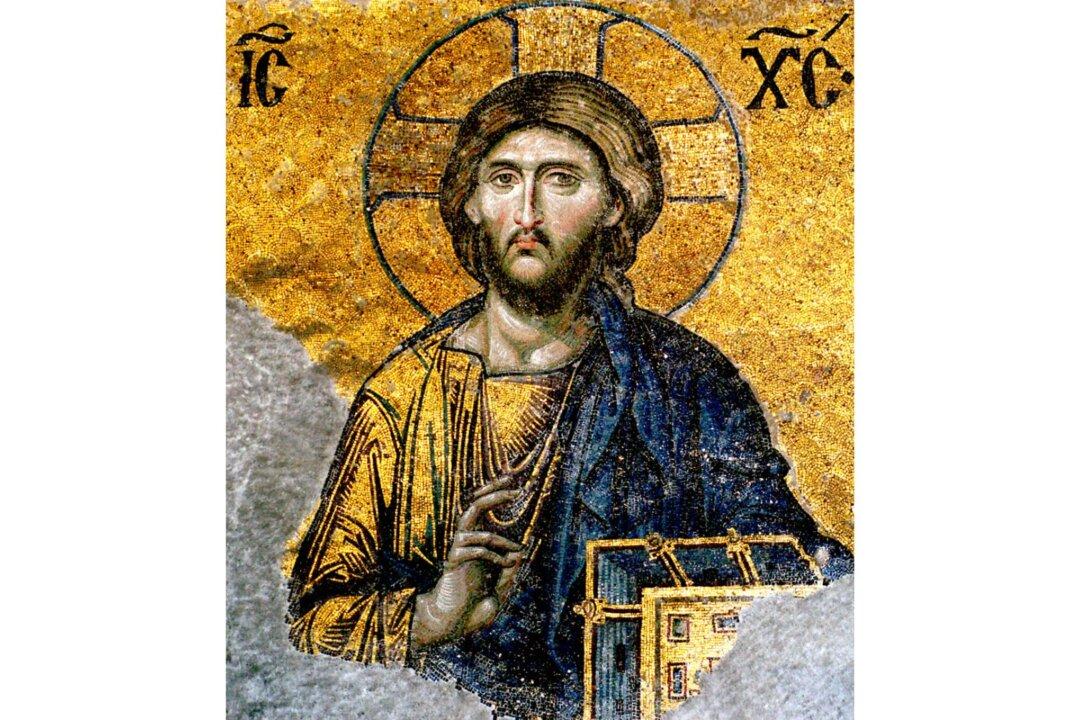For over 40 years, artist-explorer Tony Foster’s intrepid spirit has taken him far from home—paintbrush in hand—to the heights of Mount Everest, the depths of the Indian Ocean, and everywhere in between.
For 30 years, the British watercolorist has been an elected fellow at the Royal Geographical Society, London. In 2001, the society honored Foster with the Cherry Kearton Memorial Medal “for his artistic portrayal of the world’s wilderness.”
Foster often travels miles on foot, by raft, or canoe—carrying a 48-pound pack—to paint wondrous wildernesses, including the Arctic, oceans, deserts, rainforests, mountains, canyons, and the tropics.
“[Foster’s] not painting from a photograph someone else took of a wild place. He’s taken the effort. He has put in the sweat equity to get to the most beautiful places in the world to paint them,” said Whitney Western Art Museum curator Karen McWhorter in the short documentary “Painting the Green.”
He was the first artist to capture all three faces of Mount Everest.
Foster lives with his wife in the hilltop village of Tywardreath, on the Cornish coast of southwest England. He creates around two-thirds of his plein-air paintings in the wilderness, then finalizes the works in his home studio, which overlooks the village pub.
Foster’s watercolor paintings are in world-renowned art collections, including those of the Denver Art Museum, Yosemite National Park in California, and the Yale Center for British Art in New Haven, Connecticut.
Watercolor Journeys
From 1984 to date, Foster has completed 19 creative expeditions, or “journeys,” as he calls them.These journeys can be thematic, such as “Exploring Beauty,” or focused on a specific region, like “Travels Without a Donkey in Cévennes.” Each journey takes him years to paint and often entails several trips, sometimes on different continents.
Foster fuels these arduous art journeys with tenacity and tea. But in 2022, he approached Journey 18 with trepidation. The pandemic had grounded his wilderness expeditions for three years. Any explorer would be challenged by the long break, but at 76 years old, Foster really felt it. In a Foster Museum interview, he said:
“I can’t pretend my eyesight is getting any better. I can’t pretend my hand is getting steadier, and I certainly can’t pretend that I can haul 48-pound packs up mountains anymore, like I used to. … I wasn’t at all convinced that I still had either the strength or the will power or the skill to produce the kind of work I’ve been producing for the last 30, 40 years.”
He also had to adjust to creating large—sometimes 7 feet by 4 feet—watercolor paintings again, after working on his daily miniature watercolor diaries during the UK lockdowns.
Journey 18 explores three sections of the Green River, a 730-mile tributary of the Colorado River that runs through Wyoming, Utah, and Colorado. It’s Foster’s fifth river journey in the American West, and although not in the wilderness, some parts are remote. The small expedition group consisted of Foster’s eight friends, including curator Karen McWhorter, four women from Seattle, and a small documentary film crew led by director David Schendel who filmed “Painting the Green.”
The Green River Challenge
Foster has trekked across some of the world’s most spectacular places, but if he’s not careful, the most he will see are his feet—a survival necessity when exploring the wilderness. Therefore, he insists that every two hours, they stop and spark up the stove for a 30-minute tea break to appreciate the scenery. It’s an important part of the process.

He paints with a tiny Winsor & Newton watercolor paintbox that fits in the palm of his hand. Over the years, he’s changed the original colors but uses the same small paintbox in his studio too.
Watercolor paints are unforgiving, often hard to control, and leave little margin for error. Watercolor painting in the wilderness makes it more challenging, because the work is exposed to the elements and critters. Foster surrenders to the process and anticipates struggles. “Be prepared for things to be destroyed; be prepared for them to evaporate in front of your eyes because otherwise … the finished object will never have much virtue,” he said in the Foster Museum interview.
“You have to learn to be philosophical, no matter how long the painting has taken you. No matter how long you’ve sat there, it can still be blown over a cliff and it cannot become a precious object at that stage. It can’t become a precious object until it’s in its frame,” he added.
Journey 18 Paintings
Foster took around six days to paint “Steamboat Rock From 400' up a Cliff,” in situ. Each day he scaled 400 feet up the cliff to reach his vantage point, looking down across the mesa to where the Green River and Yampa River converge.
He spent 23 days painting “From Near Willow Flat Looking 240˚ South West, 2022” in situ. Foster echoes English landscape painter John Constable’s (1776–1837) penchant for clouds. Constable once proclaimed, “I am a man of clouds.” Foster shares the same sentiment, often waiting days for a dramatic sky. On day 11, an incoming storm blessed him with the lively sky he had hoped for. It was the only inclement day among the 22 blue-sky days.

One night, the rain came down like bullets. “It was Wagnerian. I mean, the sound of this thunderstorm rattling off the canyon walls was just extraordinary; I loved that; it was so dramatic,” he said.
Painting the sky last is often precarious. He needs a shady spot for the watercolor paint to dry slowly and evenly. He lays the large paintings flat, which is difficult on rocky terrain. He may also have to adjust the tones throughout the painting, as every color has to harmoniously relate to one another.
Back in his studio, Foster found an unfinished painting he’d made on a 1990 Green River canoe trip. He’d forgotten about “Upheaval Dome/A Hike to the Green River” but recalled that he wasn’t sure how to cast the complex canyon shadows. Years later, he visited an exhibition of British painter Michael Andrews (1928–95), whose painting of Ayers Rock, in Australia, taught him how to finish the red rock cast-shadows in his painting. The finished painting is in the exhibition.

The Wilderness Effect
He loves how American painter Winslow Homer (1836–1910) “could beautifully describe a landscape in about ten wonderful, deft brushstrokes.” He once tried to paint in a similar fashion, but it felt unnatural, like trying a new handwriting style.He’s seen some people take a sharp inhalation when viewing his paintings, “as if they’ve just come into fresh air.” It’s that refreshing quality he’s aiming for, and something he somewhat attributes to slowly dabbing paint onto the paper instead of applying layers of paint washes that can easily become murky rather than fresh.
Many of Foster’s watercolor paintings include small maps and actual artifacts mounted on the paper, reminiscent of the 19th-century field diaries of naturalists’ expeditions. For Journey 18, these artifacts include a Shoshone necklace, a Dine (Navajo) arrowhead, and a fossilized fish.
Long before Journey 18, one of Foster’s first loves of the Green River were the fossilized fish he gifted to friends bemoaning their 50th birthdays, along with a chipper retort: “50 is nothing; here’s something 50 million years old!” Foster’s watercolor paintings preserve these wildernesses that have existed largely untouched for millennia.








